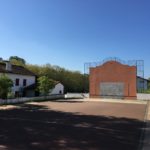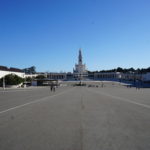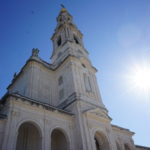Pamplona to Saint-Jean-Pied-de-Port, France – 73km
Saint-Jean-Pied-de-Port to Oloron Ste. Marie – 81km
We were sad to say goodbye to Helen and Wayne, as they headed off to San Sebastián and we, to France. We talked about possibly meeting up on the Australia leg of our tour.
We were a bit apprehensive about crossing the Pyrenees, but the gradient of the first two long climbs on the N135 was manageable. We also realized that we had started at a higher elevation (Pamplona is at 446m, while Saint-Jean-Pied-de-Port is at 259m). On one of the ascents, Paul witnessed a couple of cyclists coming down at speed, only to see the leader brake quickly which caused his partner to brake, lose control and flip over the handlebars. Her bike landed on top of her, but she was OK. Without knowing that Paul is a physician, she asked him to check her back for injuries.
The last ascent was steep, but short, and we attained the Alto de Ibaneta (1057m), where the views north and south were spectacular. An ancient stone marker, as well as a more recent one and a large Crucifix marked the Camino. Whatever one’s beliefs, it is hard not to be moved by and feel a spiritual connection with this ancient pilgrimage route, particularly from the vantage point of standing on top of the Pyrenees.
From the summit, we had an incredibly long, continual ascent for 90 minutes over 26 kms, crossing the border into France in the process. There was no sign of the border, apart from signs changed from Spanish/ Basque to French/ Basque and the fact that we were now riding on the D933.
After Saint-Jean, we noticed posters advertising the run that had been going on when we arrived in Pamplona. A taxi driver in Pamplona had told us that it is a run of 200km, with each person running 1km. He had taken part with his family and parents, starting in his home town. It is a celebration of Basque culture and straddles Spain and France. Incidentally, in Pamplona, parents can elect to have their children educated in Basque and English or Spanish and English. According to our taxi driver, 40-50% of people in Pamplona speak the Basque language.
Between Saint-Jean-Pied and Oloron Sainte Marie, we left the Pyrenees behind only to see them again more dramatically at the end of the day. The landscape of the French foothills is rolling and richly agricultural, arable, with cattle and sheep.
We happened to notice a sign indicating the location of Camp Gurs, used betwern 1939-1945 for interning nationalists fleeing Spain after the Spanish Civil War and later for German Jews living in France, some of whom were deported to concentration camps in Germany. It was a sober moment of remembrance.
Camino encounters:
– On our way to Pamplona, we had a lovely conversation with a couple from Iceland around our age who were on their honeymoon! They were cycling the Camino with electric-assisted bikes, which they were finding quite heavy for the purpose. They offered to give us advice on cycling in Iceland, which we hope to be able to take advantage of in the future.
– After coffee in Zubiri, we chatted to a cyclist from Brazil who was trying to cycle in the Camino itself. It had taken him 5 hours to get to the top of the Ibaneta the day before and he was having knee problems as a result of the steep descent today. We told him we have been cycling on the adjacent roads and gave him our cycling guide to the Camino, for which we he was very grateful.
– At lunch in Viscarret, we met a couple of Camino hikers from Oregon who had sold their house and had been travelling for two years. This was their second time doing the Camino in two years. This time they had started in Le Puy.




















